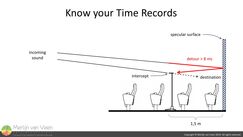
- Details
It is extremely gratifying to have accurate 3D prediction software confirm and validate tried and tested loudspeaker selection, positioning, and aiming techniques, some of which predate prediction software all together.
Industry legend Bob "6o6" McCarthy created simple but reliable methods such as Forward Aspect Ratio and Lateral Aspect Ratio which minimize variance over listening‑space, that empower audio professionals to deploy loudspeakers without computer aid.
- Details
 Specular reflections can make analyzer traces go fubar which complicates data interpretation and sets the table for poor EQ choices. Windowing or gating, in an attempt to rid ourselves of those pesky late arriving reflections, reduces the "jaggedness" in our traces, and thereby the need for excessive smoothing.
Specular reflections can make analyzer traces go fubar which complicates data interpretation and sets the table for poor EQ choices. Windowing or gating, in an attempt to rid ourselves of those pesky late arriving reflections, reduces the "jaggedness" in our traces, and thereby the need for excessive smoothing.
That being said, modern analyzers typically already apply windowing under‑the‑hood in such a way that useful (stable, early) reflections are preserved while detrimental reflections (echoes) are rejected.
While additional user‑defined windowing is often available, it typically comes at the expense of reduced frequency resolution and should be applied with caution.
- Details
In this article, I explain the first step towards reading phase traces, which is the summation of sine waves with a phase offset, using oscilloscope and phasor-scope.
- Details
By definition, it is impossible to be equally loud on‑axis to the top loudspeaker of a line array, compared to on‑axis to the second‑to‑last loudspeaker. In this short article I will explain why this is, and why overshoot is advised.